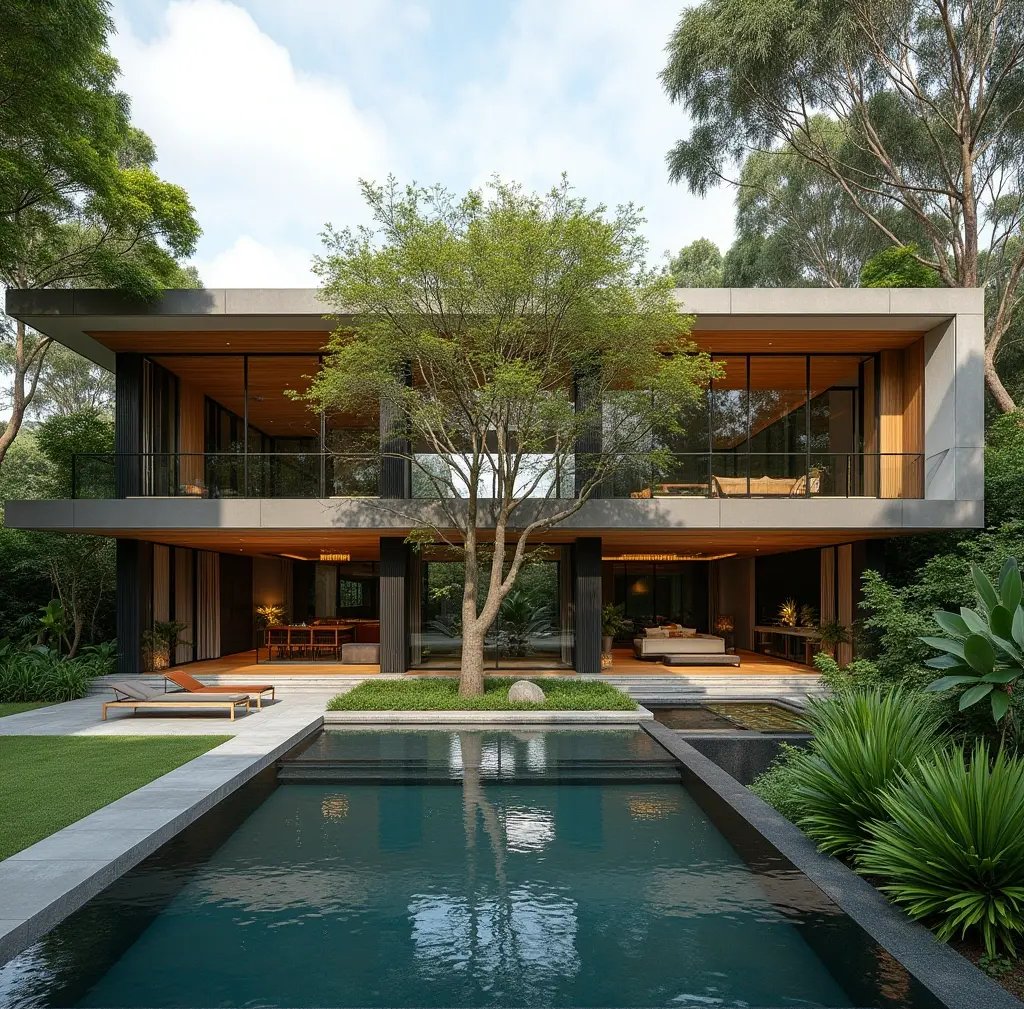Beyond Health Metrics: Profitability, Business Success, Learning, and Recovery
This article explores how data from offices, schools, hotels, and hospitals—showing measurable gains in satisfaction, productivity, learning speed, profitability, and recovery—translate directly to premium home design. By outlining key WELL principles (air quality, daylight, acoustics, materials, thermal comfort, biophilic connections, etc.), it shows how applying these strategies in residences can boost health, wellbeing, and even property value.
6/4/20255 min read


Clients often ask, “But can I justify extra cost?” Here are some real-world numbers aggregated from various sectors:
Profitability Increase (Hospitality Example):
The MGM Grand’s “Stay Well” rooms—designed with WELL-inspired amenities—delivered a 25 percent increase in profitability on that floor, prompting MGM to quadruple the Stay Well inventory.Business Success (Real Estate & Rent Premiums):
A study in Landscape and Urban Planning found that offices with higher “healthy building” scores commanded up to a 7.8 percent rent premium, and spaces with abundant daylight achieved a 5–6 percent rent premium. That translates directly to asset value: landlords and developers see better financial performance when health-oriented features are included.Education & Learning Speed (School-Design Research):
Classroom design data from the University of Salford (34 classrooms, 751 pupils) showed that optimizing natural light, acoustics, and temperature can boost academic performance by up to 25 percent over a school year. This suggests that, as schools adopt WELL’s tenets—better daylight, improved air quality, reduced noise—students learn faster and more effectively.Health & Hospitals: Faster Recovery Through Design:
Research has demonstrated that hospital rooms with large windows facing the sun for part of the day reduce recovery time from severe depression and heart attacks, compared to rooms with obstructed views. Additionally, a 2018 study revealed that hospitals designed with patient wellbeing in mind saw a 12 percent faster overall recovery rate compared to traditional setups.
These statistics come from offices, schools, hotels, and hospitals because it’s easier to quantify outcomes in those settings. However, these improvements translate directly to premium private residences:
Daylight Satisfaction (Office Study → Home): 18 percent higher daylight satisfaction among office occupants suggests that homes with optimized window placement, light shelves, and well-calibrated artificial lighting will foster better mood, sleep quality, and reduced eye strain.
Acoustical Privacy (Office Study → Home): 17 percent higher satisfaction with acoustical privacy indicates that sound-absorbing materials, isolated mechanical systems, and thoughtful spatial layouts in residences will yield quieter, more peaceful living spaces and reduce stress.
Connection to Outdoors (Office Study → Home): 16 percent higher satisfaction connecting to outdoor environments shows that private residences incorporating courtyards, balconies, or ample glazing with garden views boost occupants’ sense of wellbeing and reduce feelings of confinement.
Sick Building Syndrome Complaints (Office Study → Home): 12 percent fewer complaints in offices with better air quality and ventilation implies that residences with high-efficiency filters, properly designed air intake, and pollutant reduction strategies can significantly reduce headaches, fatigue, and respiratory irritation for homeowners.
Musculoskeletal Issues (Office Study → Home): 6 percent fewer complaints in certified spaces suggests that residential layouts encouraging movement—through easily accessible stairs, open floor plans, and ergonomic kitchens—can reduce stiffness, back pain, and improve overall physical comfort.
Thermal Comfort Satisfaction (Office Study → Home): 11 percent higher satisfaction with thermal comfort in WELL buildings suggests that residences with well-insulated envelopes, efficient shading, and calibrated HVAC systems will foster consistent comfort and productivity (or relaxation) regardless of season.
Profitability & Rent Premiums (Hotel/Office Studies → Home): While premium residences don’t “rent” per se, a 7.8 percent rent premium for healthy offices and a 25 percent profitability boost for hotel rooms translates into increased resale value and higher buyer appeal for homes that feature health-driven design elements.
Student Performance (School Study → Home): A 25 percent boost in academic performance in optimized classrooms indicates that homes designed with proper daylight, quiet zones, and thermal control will support remote learning, homework, and creative work, enabling family members—especially children—to learn more effectively.
Faster Recovery (Hospital Study → Home): A 12 percent faster recovery rate in hospital rooms with daylight and nature views suggests that residences with similar features—large operable windows, healthy material choices, and noise reduction—support quicker recuperation from illness, reduced stress, and faster return to daily routines.
By understanding how these quantified benefits from offices, schools, hotels, and hospitals apply to homes, architects can advocate for design strategies that improve health, wellbeing, and property value in the premium residential market.
Embracing WELL Principles as a Registered Architect
I’m not here to preach from a WELL AP’s pulpit; I’m simply sharing what I’ve learned as a practicing architect. If you’re curious about WELL but not certified, consider:
Air Filtration Upgrades: Even a modest HVAC filter bump (e.g., moving from MERV 8 to MERV 13) can support cleaner air, reducing Sick Building Syndrome complaints by about 12 percent.
Daylight Controls: Simple light shelves or automated blinds tied to a sensor can boost daylight satisfaction by 18 percent.
Low-VOC Materials: Choosing paints and adhesives with certified low VOCs reduces occupant irritation. Commercial WELL data is clear that material selections matter.
Acoustic Treatments: Adding sound-absorptive panels or isolating mechanical equipment can drive a 17 percent increase in acoustical privacy satisfaction.
Biophilic Touchpoints: Incorporating indoor plants or visual connections to nature can contribute to a 16 percent boost in connection to outdoors satisfaction.
These steps don’t require thousand-page manuals. They’re straightforward design choices—aligning code-minimum compliance with evidence-backed strategies to improve health, focus, and (yes) property value.
Let’s Keep Learning and Sharing
If you’ve experimented with any of these strategies—perhaps a daylight study that changed your window-to-wall ratio or a material swap that cut down VOCs—drop a comment below. What questions do you have about translating WELL research into luxury home design? For those still in the “WELL alphabet soup” stage, let’s demystify it together:
Which concept feels most relevant to your next project?
Where do you see pushback from clients, and how can we address it?
How might we quantify “health ROI” for a $5 million penthouse?
We’re on a journey together. I’m a registered architect, not a WELL AP—but embracing these principles can only improve our work and our clients’ lives. When design prioritizes human health, everything else—finishes, fixtures, bespoke joinery—becomes that much more meaningful.
Sources & Further Reading
International WELL Building Institute (IWBI), “The potential of high-performance workplaces for boosting worker productivity, health, and creativity: A comparison between WELL and non-WELL certified environments,” Building & Environment, Sept 2023.
Ildiri, N. et al., “Impact of WELL Certification on Occupant Satisfaction and Perceived Health, Well-being, and Productivity: A Multi-Office Pre-Versus Post-Occupancy Evaluation,” Building & Environment, Oct 2022.
DELos, “MGM Grand’s Stay Well Rooms Boost Profitability by 25 Percent.”
Van Den Weyn et al., “Taking a Healthy Building Approach Pays Back: Up to 7.8 Percent Rent Premium for Healthy Buildings,” Landscape and Urban Planning, 2021.
University of Salford & Nightingale Associates, “School design influences learning,” Wired, Jan 2013.
Joseph et al., “The role of hospital design in improving patient recovery,” International Journal of Advanced Research, 2018.
International WELL Building Institute (IWBI), “Evidence Box: Light,” 2021.
TIME, “Hospitals Should Be Redesigned to Improve Care,” Jan 2024.
WELL Building Standard, Wikipedia.
Ready to bring WELL-inspired design into your next project? Leave a comment below with your thoughts, questions, or experiences—let’s continue the conversation about creating healthier, happier homes. If you’re curious about how these principles could transform your residence, get in touch to explore ideas together.
Get in touch
© Wigwam Architects
Wigwam Architects Pty Ltd ATF Wigwam Trust ABN 77 283 233 729
Wigwam Architects respectfully acknowledges the Quandamooka people as the Traditional Custodians of the land on which we live and work. We honor their enduring connection to Country, community, and culture and recognize their deep knowledge and care for this land and its waterways. We pay our respects to Elders past, present, and emerging and extend that respect to all Aboriginal and Torres Strait Islander peoples today.


